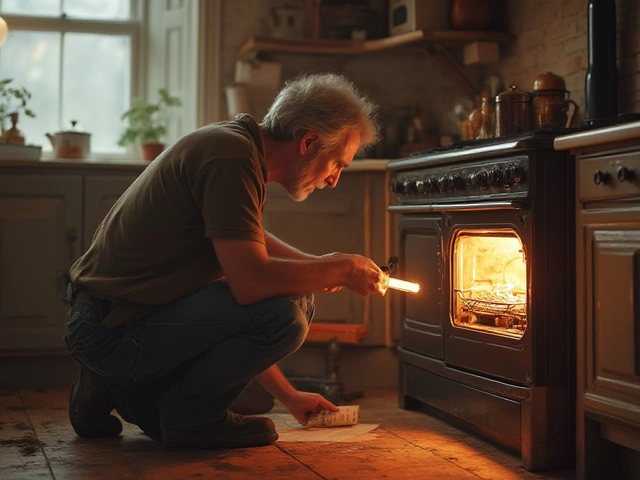If your gas oven won’t light, the igniter is often the culprit. A weak or broken igniter means the gas never sparks, leaving you with a cold oven and a frustrated dinner plan. The good news? Most igniters are cheap and can be swapped in under an hour with basic tools. Below we’ll walk through the signs, the tools you need, and the exact steps to get your oven heating again. And if you hit a snag, we’ll tell you when it’s smarter to call a local pro.
The igniter is a small, glowing coil that heats up when you turn the oven on. If it’s cracked, corroded, or simply worn out, it won’t reach the temperature needed to ignite the gas. Common clues include a faint click, no glow, or a smell of gas that disappears quickly. You might also notice the oven takes longer than usual to reach the set temperature, or it never gets hot at all. Checking the igniter first saves you from pulling apart the whole oven needlessly.
Tools you’ll need: screwdriver set, nut driver, multimeter (optional), safety gloves, and the correct replacement igniter model for your oven. Most manufacturers list the part number on the original igniter or in the owner’s manual.
1. Safety first. Turn off the oven and unplug it. If you can’t reach the plug, switch off the circuit breaker for the kitchen. Let the oven cool completely – the igniter gets extremely hot during operation.
2. Locate the igniter. Open the oven door and remove the bottom panel or the rear access panel. In many models the igniter sits just behind the burner, held in place by a couple of screws or clips.
3. Test (optional). If you have a multimeter, set it to check resistance. A healthy igniter usually reads between 30‑70 ohms. A reading outside that range confirms it’s bad.
4. Remove the old igniter. Unscrew the mounting screws, gently pull the igniter out, and disconnect any wire connector. Be careful – the wires can be brittle.
5. Install the new igniter. Connect the wire plug, slot the new igniter into the same position, and tighten the screws. Make sure it sits flush and isn’t touching any metal parts that could cause a short.
6. Re‑assemble and test. Put the panels back, plug the oven in, and turn it on. You should see a bright orange glow within a second and hear the gas ignite. If it still doesn’t light, double‑check the wiring and consider other issues like a faulty gas valve.
Replacing an igniter is straightforward, but a few things can trip you up. Keep your workspace clean, label any screws you remove, and never force a connector – a broken clip can cost extra time.
When to call a professional. If the igniter tests fine but the oven still won’t light, the problem could be deeper in the gas supply line or the control board. At that point it’s safer to let a qualified Bognor Regis Appliance Repair Expert handle the job. Our technicians have the tools and certifications to work with gas components safely and get your oven back to normal quickly.
Ready to tackle the igniter yourself? Grab the right part, follow the steps above, and you’ll likely have a hot oven again in under an hour. Still unsure? Give Bognor Regis Appliance Repair Experts a call – we’re on hand for fast, reliable service in the Bognor Regis area.

Learn the typical cost of repairing a gas oven igniter, compare DIY vs professional pricing, and discover tips to keep your repair bill low.

Got a cold oven? Learn if you can swap that faulty heating element yourself, what tools you'll need, and exactly what to watch out for. Easy fixes, with real-life tips.

A malfunctioning boiler can be a real nuisance, especially during the cold months. Understanding whether a broken boiler constitutes an emergency is crucial. This article provides insights into when to prioritize boiler repairs, potential risks associated with delayed attention, and essential DIY tips to consider before professional help arrives. Dive into valuable advice on maintaining your heating system efficiently.

Discover the essential roles appliances play in our daily lives and learn effective tips for maintaining their efficiency. From refrigerators to washing machines, each appliance features unique mechanics tailored for specific tasks. Grasping these functions is crucial for efficient servicing and longevity. Uncover surprising facts about how appliances work and ground yourself in practical maintenance advice to keep them running smoothly.

A reliable heat pump is essential for maintaining comfort in your home. Some signs indicate that your heat pump might need replacing, such as increased energy bills, inconsistent temperatures, strange noises, old age, and frequent repairs. Understanding these warning signs can help you decide if it's time to invest in a new system.

Replacing an extractor fan might seem challenging, but with the right tools and some guidance, it can be done efficiently. This guide outlines the process of replacing an extractor fan, from identifying signs it needs replacement to understanding how to choose the right model. Learn practical tips for handling installation and maintaining safety during the project. Make this task more approachable with easy-to-follow steps designed for beginners.